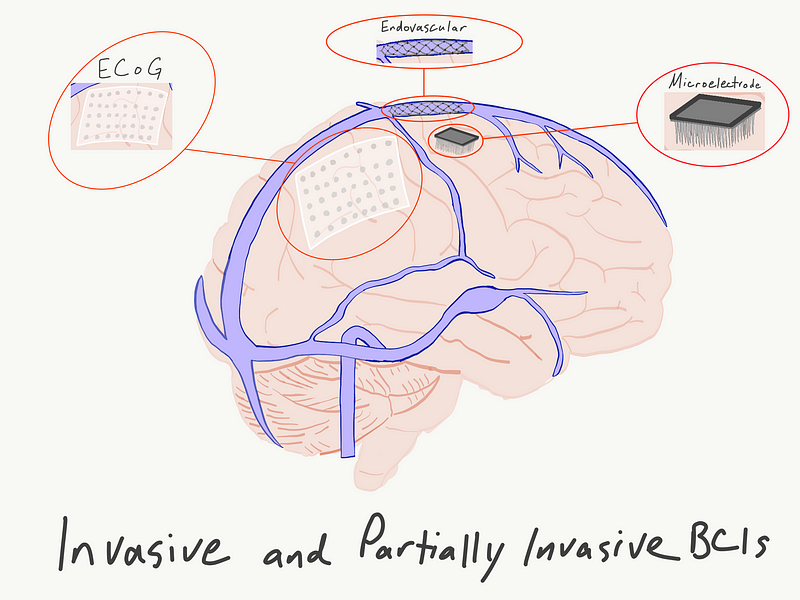The Future of Brain-Computer Interfaces: Bridging Minds and Machines
Written on
Chapter 1: Introduction to Brain-Computer Interfaces
In the realms of technology and neuroscience, a groundbreaking intersection exists where the human brain interfaces with external devices, opening a realm of endless possibilities. This captivating area is known as Brain-Computer Interfaces (BCIs) or Brain-Machine Interfaces (BMIs). BCIs create a direct connection between our minds and various technologies such as computers and prosthetic limbs. Join us as we delve into the intriguing world of BCIs, examining their purpose, components, applications, and the ethical dilemmas they pose.
This transformative technology shines as a beacon in the medical field, offering hope to those facing significant motor disabilities. For individuals who have lost the ability to move or communicate, BCIs can act as vital lifelines, restoring both communication and control.
BCIs also play a crucial role in neuro-rehabilitation. Patients recovering from severe conditions like strokes, spinal cord injuries, or traumatic brain injuries can gain significant benefits from these systems, aiding them in reclaiming lost functionalities.
Integrating BCIs with neuro-prosthetics has led to the development of artificial limbs that respond to thought commands. This extraordinary technology enables amputees and individuals with limb disabilities to perform complex movements with ease.

These advanced systems provide a means of communication for individuals confined by conditions such as locked-in syndrome or Amyotrophic Lateral Sclerosis (ALS). By interpreting their thoughts, BCIs facilitate communication through text or synthesized speech.
Beyond their clinical applications, BCIs are invaluable tools for researchers seeking to understand the complexities of the brain. They offer insights into brain function, helping scientists explore the intricacies of cognition and behavior.
BCIs utilize specialized sensors like EEG (Electroencephalography) or fNIRS (functional Near-Infrared Spectroscopy) to capture brain signals. Depending on the application, these sensors can be either non-invasive or semi-invasive.
Advanced algorithms analyze the raw brain data, uncovering meaningful information and patterns within neural signals. This processed data is then converted into commands that external devices can interpret and act upon, ranging from moving a cursor on a screen to controlling a robotic limb.

Users often receive feedback—whether visual, auditory, or sensory—which aids them in learning to control BCIs effectively.
Non-invasive BCIs typically involve placing sensors on the scalp to capture EEG signals, making them ideal for applications like communication aids. In contrast, invasive BCIs require electrodes to be implanted directly in the brain. While these offer greater precision, they are generally used for medical and research purposes.
Hybrid systems that combine both non-invasive and invasive components leverage the strengths of each method, optimizing both performance and safety.
However, invasive BCIs come with inherent risks, raising ethical questions about informed consent, privacy, and the responsible usage of sensitive brain data. Although the accuracy of this technology is continuously improving, ensuring consistent and reliable performance remains a significant challenge.

Significant advancements are being made to enhance the accessibility, affordability, and portability of BCIs, paving the way for wider adoption. Understanding how the brain adapts to BCIs is a vital area of study, revealing the remarkable adaptability of the human brain.
As BCIs become more integrated into everyday life, concerns regarding privacy and data security intensify. Protecting the confidentiality of one’s thoughts is a critical ethical consideration.
BCIs challenge the distinction between therapy and enhancement, prompting discussions about the potential for cognitive augmentation and its societal implications.
Brain-computer interfaces stand as a testament to human creativity and innovation. They provide new opportunities for individuals who have lost hope due to physical constraints, empower researchers to delve deeper into the mysteries of the brain, and promise a future where minds and machines work in harmony. Nevertheless, this new frontier presents ethical and technical hurdles. As BCIs evolve, we must responsibly navigate these uncharted territories, ensuring that this powerful technology serves the greater good.
Chapter 2: Exploring BCI Technologies
The first video, "Merging human and machine | Brain-computer interfaces | Doctor explains," provides an in-depth overview of how BCIs work and their potential applications.
The second video, "The Past, Present, & Future of Brain-Computer Interfaces By Rolando Masís-Obando," explores the historical context and future possibilities of BCIs.